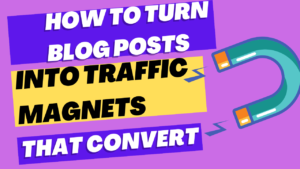How To Turn Blog Posts Into Traffic Magnets That Convert

Blogging isn’t dead—it’s just smarter. In today’s digital world, a blog post isn’t just a piece of content. It’s a strategic tool that can drive massive traffic, build trust, and convert readers into loyal customers. But not all blogs are created equal. If you’re not seeing results, it’s probably not what you’re saying—it’s how you’re saying it.
Here’s how to transform your blog into a traffic magnet that actually converts.
1. Start With The Right Keyword Strategy
Before writing a single word, you need a keyword game plan. That means understanding what your audience is searching for—and how they’re searching for it.
Focus on:
Long-tail keywords: Instead of “coffee,” target “best coffee machines for small kitchens.”
Search intent: Are users looking to buy, learn, or compare? Match your content with their intent.
Tools to use: Google’s Keyword Planner, Ubersuggest, or SEMrush are great for finding opportunities.
Pro Tip: Look at what your competitors are ranking for and create better, more valuable content around those keywords.
2. Make Your Headlines Irresistible
Your headline is your first impression. It’s what determines if someone clicks or scrolls past.
A high-converting headline:
Includes the main keyword
Offers a clear benefit or value
Sparks curiosity
Good example:
Instead of “Marketing Tips for Small Businesses”, go with “10 Proven Marketing Tactics Small Businesses Use To Triple Their Sales.”
Sites like Buzzfeed and HubSpot dominate with click-worthy titles that promise specific, desirable outcomes.
3. Deliver Real Value (Not Just Fluff)
Google ranks pages that are helpful. Your readers expect answers, solutions, or insight—not just keyword-stuffed paragraphs.
Here’s what to do:
Break up long paragraphs into skimmable chunks
Use bullet points and subheadings (like this article)
Add statistics, examples, and expert quotes
Example: NerdWallet uses in-depth, well-structured blog posts to rank for high-intent financial queries. Their guides aren’t just informative—they’re conversion machines.
4. Add Clear, Strategic CTAs
Traffic means nothing if it doesn’t convert. Your blog needs clear calls to action (CTAs) that move the reader forward.
CTAs can include:
Signing up for a newsletter
Downloading a free resource
Scheduling a consultation
Purchasing a product
Make sure each CTA feels natural—not forced. It should match the content and the reader’s stage in the journey.
5. Optimize for Search—But Write for People
Search engine optimization (SEO) helps your post get discovered. But readability keeps people engaged and drives conversions.
SEO must-haves:
Meta descriptions with keywords
Proper header hierarchy (H1, H2, H3)
Internal linking to relevant posts/pages
Alt text for images
Fast load time and mobile responsiveness
But always write in a conversational tone. Use “you” and “your.” Ask questions. Be human.
Look at Shopify’s blog—their content is written for real entrepreneurs with real problems. That’s why it ranks and converts.
6. Update and Repurpose Old Posts
Your old content could be a goldmine. Refreshing blog posts with updated stats, links, or new insights can boost your traffic overnight.
Bonus tip:
Repurpose a high-performing blog post into:
A YouTube video
A podcast episode
A downloadable PDF
A series of social media posts
HubSpot is a master at repurposing content across platforms while keeping SEO value intact.
7. Promote Like You Mean It
Writing a blog post is only half the job. Promotion gets eyeballs.
Share your post on:
LinkedIn and Twitter/X (especially for B2B)
Email newsletters
Niche Reddit or Facebook groups
Forums like Quora or Stack Exchange
You can also run paid ads on high-performing posts that bring in leads.
8. Track, Analyze, Improve
Install Google Analytics and Google Search Console. Watch what’s working—traffic sources, bounce rates, conversion paths.
If a blog gets lots of views but no conversions? Test a new CTA. If a post ranks but doesn’t get clicks? Rework the headline and meta description.
Buffer does this routinely to optimize every piece of content for performance—not just publishing volume.
Big brands like Shopify, HubSpot, NerdWallet, and Buffer use blogging as a central part of their marketing strategy. You can too—with the right mix of SEO, smart structure, and meaningful value.
Start with what your audience is asking. Answer it better than anyone else. Then, invite them to take the next step.
That’s how you turn blog posts into traffic magnets that convert.
From Zero to $37.76 Billion: How Blogging Built HubSpot Into a Marketing Giant When no one knew their name, HubSpot wrote blog posts. That’s it. No ads, no fancy tricks—just pure, valuable content. Fast forward to 2025, and they’re worth $37.76 billion USD. Their secret? Blogging was the engine. Want to grow like HubSpot? Start creating your blog and start writing. It all starts with one click.




















